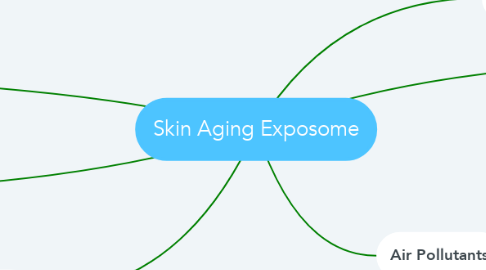Skin Aging Exposome
by Sana Ali


1. Sun Radiation
1.1. UVR
1.1.1. UVB
1.1.2. UVA2
1.1.3. UVA1 (major contributor)
1.2. VLR
1.2.1. Voilet
1.2.2. Indigo
1.2.3. Blue (major contributor)
1.2.4. Green
1.2.5. Yellow
1.2.6. Orange
1.2.7. Red
1.3. IRR
2. Air Pollutants
2.1. Lead
2.2. PM (major contributor)
2.2.1. Fine Particles
2.2.2. Coarse Particles
2.3. Gases
2.3.1. Carbon Monooxide
2.3.2. Sulphur Oxide
2.3.3. Nitrogen Oxide (major contributor)
2.3.4. Ozone (major contributor)
3. Tobacco Smoke
3.1. Nicotine
3.2. Carbon monoxide
3.3. Tar
3.4. Formaldehyde
3.5. Cyanhydric acid
3.6. Ammonia
3.7. Mercury
3.8. Lead
3.9. Cadmium
4. Nutrition
4.1. Alcohol
4.2. Antioxidant rich diet
4.2.1. Vitamins
4.2.1.1. Vitamin C
4.2.1.2. Vitamin E
4.2.2. Flavonoids
4.2.3. Carotenoids
4.2.4. Tocopherols
4.3. High Fat Diet
4.4. High Carbohydrate Diet
4.5. Vegetable Oils
4.6. Olive Oils
4.7. Legumes
4.8. Butter
4.9. Meat
4.10. Dairy Products
4.11. Coffee
4.12. Sugar
4.12.1. Exogenous AGEs
4.12.2. Endogenous AGEs
5. Cosmetic Products
5.1. Sunscreens
5.2. Topical Antioxidants
6. Miscellaneous Factors
6.1. Stress
6.1.1. Epidermal Permeability
6.1.2. Increased ROS Production
6.1.3. Pro-Inflammatory Cytokines
6.1.4. Neurogenic Inflammatory Pathways
6.1.4.1. Cortisol
6.1.4.2. Catecholamines
6.1.4.3. Neuropeptides
6.2. Sleep Deprivation
6.2.1. Epidermal Permeability
6.3. Temperature
6.3.1. Heat
6.3.1.1. Oxidative DNA Damage
